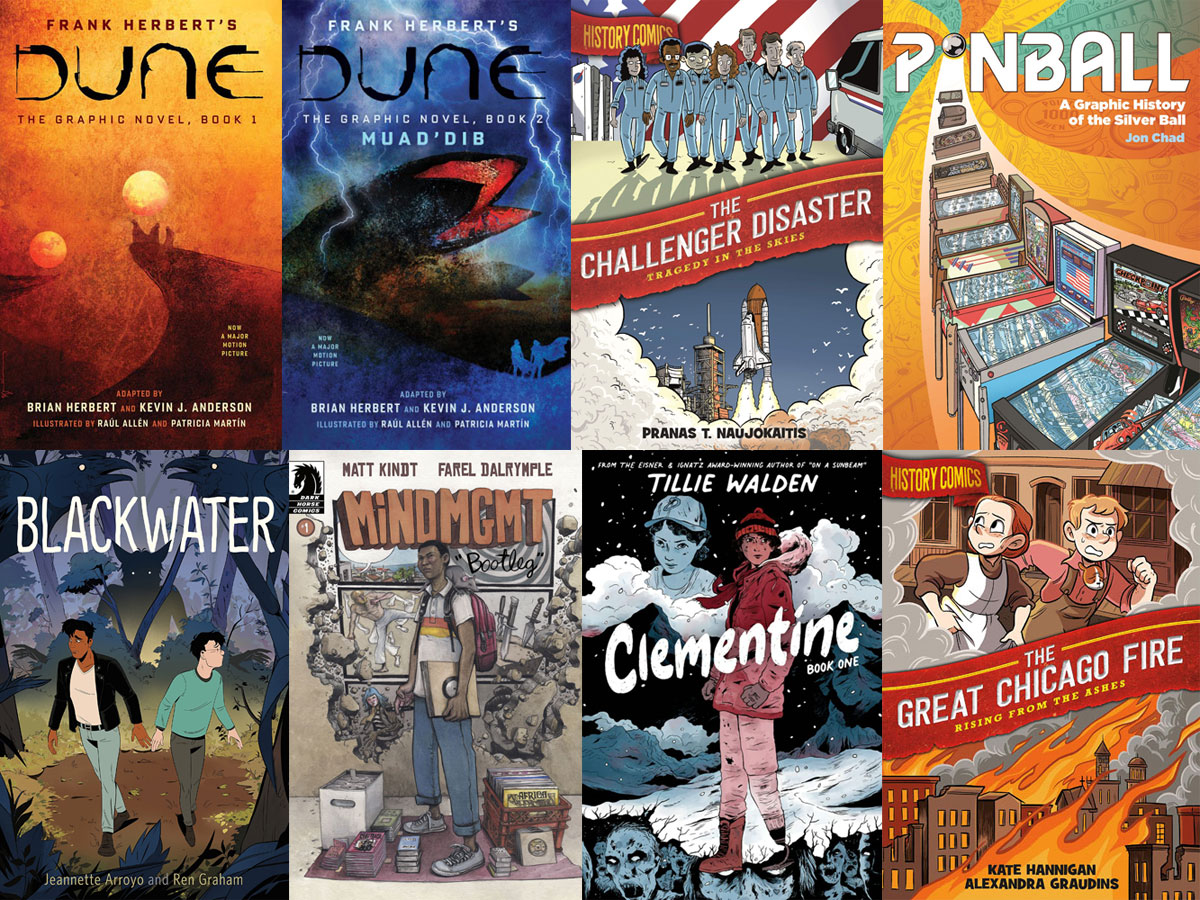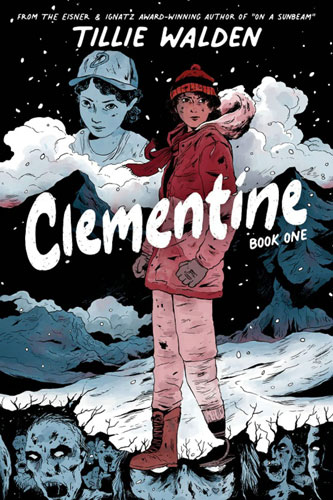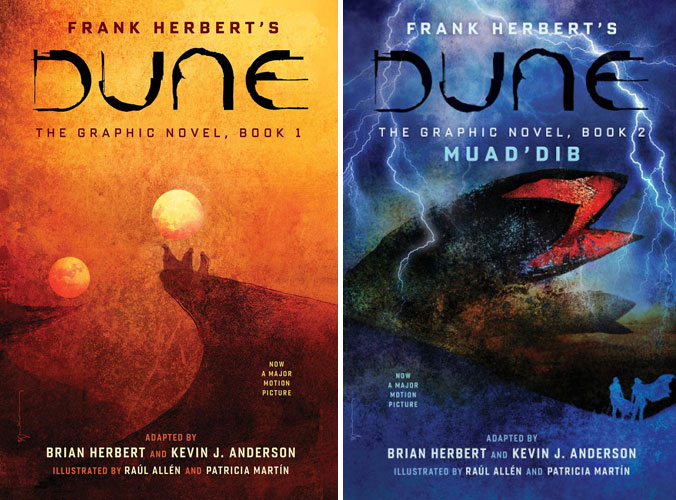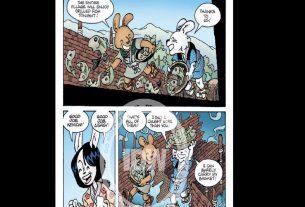Hey, let’s kick off this week with another stack of comics!
History Comics: The Great Chicago Fire: Rising From the Ashes by Kate Hannigan and Alex Graudins
History Comics: The Challenger Disaster: Tragedy in the Skies by Pranas T. Naujokaitis
A couple of weeks ago I wrote about History Comics: The Stonewall Riots, and I’ve caught up on two more of the titles in the series in the meantime, both about significant disasters but otherwise quite different from each other.
The Great Chicago Fire is told from the point of view of J.P. and Franny, two Irish-American kids who get separated from their parents the night of the fire. They also happen to be neighbors of the infamous Mrs. O’Leary, who was widely blamed for the fire because it started on her farm. This book tells a different story, offering other possibilities for how the fire may have started, and also showing the anti-Irish sentiment that made it easy to pick O’Leary as a scapegoat.
While I knew about the fire, I really didn’t know a lot of the details—how big it was, how many buildings were lost, and what firefighting measures were in place at the time. The comic, though fictionalized, follows the path of the fire through Chicago as the two kids search for their parents. The book also describes the aftermath of the fire, including the way that other cities sent aid. It concludes with an epilogue set 22 years later, at the World’s Columbian Exposition in 1893, with all of its technological wonders, and explains the influence that the fire had on architecture and buildings. It’s a story about a huge tragedy and the way the city overcame it (though, as the “Fast Facts” section notes, most of the Exposition buildings were also later destroyed by fire).
The Challenger Disaster covers an event that I’m much more familiar with, because I grew up on the Space Coast in Florida and witnessed the Challenger launch with my own eyes. The framing story in this one is a group of school kids giving their Challenger Day presentations; they’re on a space station orbiting Mars, and the year is 2386—the 400th anniversary of the disaster. Each kid, as well as the teacher, presents a bit of the story: the engineering behind the Orbiter and how it functioned, the crew of the Challenger and how a teacher ended up on a space shuttle, and the investigation into how the malfunction happened.
I realized that, although I’d already learned about how the space shuttle worked and what caused the explosion, I didn’t really know that much about the crew other than Christa McAuliffe, the teacher who was eventually chosen as the first private citizen to go to space. And, as many times as I’ve already read about the way the events unfolded, it always still hits me when I see that chaotic plume of smoke. I also had known about what caused the explosion—those frozen O-rings—but I had forgotten that Richard Fenyman played a key role in that investigation.
The framing story paints an optimistic picture of the future of the space program: the kids are in space, and while there are still dangers to life in space—as illustrated by a close call that happens in the book—space travel has become much more normal to these kids. It is also—perhaps even more optimistically—a time in which prejudice has become a thing of the past, as the kids have a hard time understanding at first why it’s such a big deal for somebody to be the first woman in space, or the first Black man in space, and so on. The teacher gives a brief lesson about 20th century culture, which they find hard to believe. I can only hope that we eventually get to that place.
It was also a bit sad to me, reading this story about a time when it felt like there was a sense of excitement about space travel and exploration, when now it feels like it is becoming more and more limited to strictly commercial enterprises, or at a time when it feels like going to space may be a frivolous waste of resources when we have so many other problems to deal with. At the same time, I’ve always believed that the drive to go to space has led to a lot of scientific advancements that are useful even for us Earthbound people, so I do hope we don’t entirely give up on the idea.
Pinball: A Graphic History of the Silver Ball by Jon Chad
I’m not a pinball enthusiast, but this book made me wish I were. Jon Chad, who has also done a couple of Science Comics titles and—a decade ago—the Leo Geo book about geology, does an expert job with his subject. In fact, it feels a lot like a plus-sized Science Comics title, nearly double the length of those books but with a lot of the same types of diagrams and explanations of how things work.
Chad begins by making the argument that pinball is an art form, one that uniquely engages the player in a conversation with an infinite number of possible outcomes. He gives a very brief history about how pinball almost died out in 1976, and then jumps back—way back—into its history, the various technological advances that changed the way machines worked, and then leading up to a hearing in 1976 to re-legalize pinball (after it had been outlawed in New York City in 1942). He explains what makes pinball a game of skill rather than luck, and what sets it apart from other interactive experiences like videogames. It’s a compelling argument!
Throughout the book, Chad also includes plenty of examples of actual pinball machines and their notable features, as well as the rise and fall of the various companies that made the machines. It ends on a hopeful note, because pinball has experienced a resurge in popularity in the past few years. At the back, along with a glossary of terms, there’s also a section on basic flipper skills to show the various ways that pinball players can catch, hold, and pass the ball between flippers. I really enjoyed this one, and it gave me a deeper level of appreciation for pinball, particularly the technology behind the machines.
Blackwater by Jeannette Arroyo and Ren Graham
This graphic novel for YA readers has it all: werewolves, ghosts, and romance. Tony Price is one of the cool kids—a star on the track, though he wishes his dad were around more often to see it. Eli Hirsch has an autoimmune disorder and is frequently out sick, which does nothing for his grades or his social life. But after Tony sticks up for Eli to a bully, they eventually start to get to know each other.
Oh, and then Tony gets bit by a werewolf.
Tony’s own transformations seem to be driven by his emotions, and since he’s now wrestling with a lot of confusing feelings (for instance, his longtime friend Biff was the bully), he has a hard time keeping his monster side under control. In the meantime, Eli is haunted by a creepy ghost fisherman and can’t figure out why.
There’s a lot of poor communication and bad feelings involved as both Tony and Eli make assumptions about the other and figure out their own feelings, but ultimately—with the help of Tony’s goth friend Marcia—they figure things out a bit more. The story does feel a little bit chaotic at points, jumping from scene to scene or navigating the ups and downs of various characters’ moods, but overall it was a fun read. How none of the other folks figured out that Tony was actually werewolf, even though his teeth stayed pointy when he was in human form? That’s the real mystery.
Clementine Book One by Tillie Walden
I’ve read several of Tillie Walden’s other comics, so I was really curious about this one, which is set in the world of The Walking Dead, even though I haven’t really kept up with that franchise (either the comic books or the TV series). I gather that Clementine does show up in the Fear the Walking Dead series and is also the subject of a videogame, but I haven’t seen or played either of those myself.
At any rate, when we meet Clementine, she’s on her own, hiking with crutches because she’s missing a foot, casually dispatching zombies as they cross her path. She comes across an Amish community, who set her up with a few supplies and a new prosthetic leg, before setting out on her way again—she’s not really interested in being around other people. But then, Amos, an Amish boy who is setting out for his Rumpspringa rite of passage, is headed the same direction in his carriage and she finally agrees to ride along with him. His naivete about the outside world shocks her, and she ends up sticking with him to make sure he gets to his destination.
I don’t want to give away much more, but they do encounter other folks eventually, people who have their own agendas and are equally distrustful of others. What’s interesting to me is that, although it’s a Walking Dead story, the zombies are almost peripheral to the tale. They show up, they attack at crucial plot points, but largely this is a story about how people treat each other in this new world, seven years after everything fell apart.
Book Two is expected out in October this year, and I’m excited to see where Clementine goes from here.
Mind MGMT: Bootleg by Matt Kindt and Farel Dalrymple
The Mind MGMT series concluded with the destruction of the agency—at least, temporarily. This secret organization of people with psychic abilities had a lot of control over world events, but a group of rogue agents were able to take it all down. Now, a former leader is trying to recruit new agents to rebuild Mind MGMT, which kicks off this new series. In Bootleg, a young Black man named Kito in Zanzibar finds himself able to spot hidden messages around him—in his comic books, on billboards, and he winds up at a recruiting station where he’s given a series of strange tests.
This new book also overlaps with the Mind MGMT board game, which is billed as a recruiting tool for the agency—there’s an allusion to the game in this new comic (along with an actual ad for the game at the back of the book). It’s a fun way to have the comic bleed into reality, and to pull the game into the world of the comic. I’ve only read the first 32-page issue, though the link above appears to be for a 96-page hardcover, so I’m going to have to look up the rest of this story soon!
Dune: The Graphic Novel Book 1 and Book 2: Muad’Dib adapted by Brian Herbert and Kevin J. Anderson, illustrated by Raúl Allén and Patricia Martín
Geek confession: I’ve never read Dune, nor have I seen any of the film adaptations. I’m vaguely familiar with some of the concepts—the spice, the sandworms, stillsuits—but really most of what I knew about any of the characters or locations came from playing the game Dune: Imperium, and even then it was the most cursory overview. But, hey, it’s never too late to start, right? I figured this graphic novel adaptation would be an easy way to dive into the world of Dune and see what it’s all about.
The graphic novels, which have been adapted by Frank Herbert’s son Brian and sci-fi author Kevin J. Anderson, have taken the original three-part book and turned it into three volumes for the comics. The first two are available now, with a final volume in the works. Book 1 sets the scene: we’re introduced to a slew of characters, given a peek at all of the political intrigue, and then we arrive at the desert planet Arrakis, also known as Dune. There, Baron Harkonnen’s plot to destroy Duke Leto (who has been given control of Arrakis by the emperor) starts to unfold, eventually leading to the duke’s death, with his wife and son escaping into the desert. (Cue giant sandworms.)
Paul, the duke’s heir, is set up as a Messiah figure—he’s been trained by his mother in the ways of the Bene Gesserit, and has visions and dreams. As he encounters various people throughout the story, many of them sense a difference in this young man, but he’s worried about a terrible future that he foresees. Book 2 focuses primarily on Paul’s journey with his mother Jessica through the desert, seeking sanctuary among the indigenous Fremen, though we do check in from time to time on the rest of Baron Harkonnen’s scheming.
I can see why Dune has such a following, and I can see its influences on a lot of stories that came later. The desert world, the rituals and practices the Fremen have concerning water, the massive sandworms, the backstabbing and maneuvering—there’s a lot going on here and an incredible world filled with unusual characters. But there are also things that feel a bit tiresome, reading it now in 2022: a whole order of women with mystical powers who are awaiting the one man who can see what they cannot. The colonizer who sides with the colonized and becomes their savior. And, despite my enjoyment of the story itself, I couldn’t help laughing at how strange it seemed that some of the characters had such plain-sounding names. On the one hand, you have people like Gurney Halleck and Thufir Hawat and Stilgar, but then the central figure is named Paul, and is mother is Jessica. It just seems so out of place.
The artwork in the comics is excellent, bringing to life a new world and unfamiliar technology. They make great use of color, too, with sections saturated in a particular color to evoke a particular feeling: the desert is full of reds and oranges by day, and blues by night.
Since I haven’t read the original, it’s hard for me to compare, but in the introduction Herbert and Anderson explain that they really wanted to stick to the original—this book is meant to be a faithful adaptation and not a personal interpretation of it. So I’m guessing that a lot of the dialogue and descriptions are probably taken directly from the original, even when they may seem a little stilted when translated into the comics format. In places where characters have internal monologues, the comics uses different colored text boxes to distinguish them, which is useful once you figure out which character is which color. However, there are times when spoken dialogue carries over into a different image, and then it’s just a regular white text box—without more context, I often had trouble figuring out who was speaking.
For the most part, though, I enjoyed reading both volumes and it left me wanting to find out how this story concludes. I don’t know that it’ll make me a diehard Dune fan, but I’m at least interested enough to keep reading—and I’m still keeping the novel itself on my reading list.
Disclosure: I received review copies of these titles. Affiliate links to Bookshop.org help support my writing and independent bookstores!










